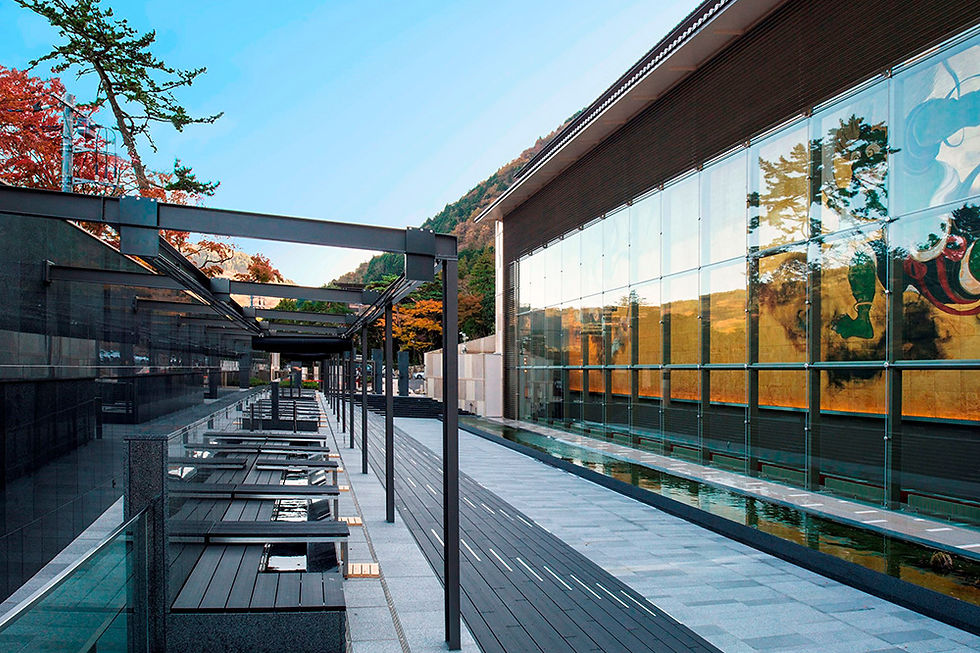宋代筆記 vol.152 岡田美術館:北宋青磁刻花牡丹文鉢 - Okada Museum, Yaozhou Celadon Peony Vessel, Northern Song Dynasty
- SACA

- Oct 3
- 3 min read
Updated: Oct 7

北宋青磁刻花牡丹文鉢
耀州窯
北宋(11~12世紀)
高4.8公分 口徑21.0公分 底徑6.3公分
北宋時期(960–1127),陝西耀州窯燒造大量青磁器,其特徵在於橄欖綠色釉與「片切彫」技法——即自外側斜向刀入,沿文樣輪廓刻出,以形成清晰立體的裝飾效果。
此鉢器壁以片切彫雕飾盛開牡丹一枝,刻痕處青釉厚聚,因而產生濃淡漸變,令花瓣仿若浮現於釉層之中。口緣設六處細切,成規整輪花形。器形端整,釉色勻淨雅潤,刻線銳利勁健,堪稱耀州窯全盛期之佳作。
Yaozhou Celadon Carved Peony Bowl
Yaozhou Kiln
Northern Song Dynasty (11th–12th century)
Height 4.8 cm, Mouth diameter 21.0 cm, Foot diameter 6.3 cm
During the Northern Song dynasty (960–1127), the Yaozhou kilns of Shaanxi province produced a wide range of celadon wares characterized by an olive-green glaze and the distinctive kata-kiribori carving technique—incising diagonally from the outline toward the interior to create sharply defined motifs.
This bowl is decorated with a boldly rendered branch of peony carved in this technique. The glaze pools thickly within the incisions, resulting in subtle gradations of tone that cause the design to stand out as though in relief. The rim is fashioned with six notches to form a lobed outline. With its harmonious proportions, refined glaze, and incisive carving, this piece exemplifies the artistic peak of Yaozhou celadon production.
青磁刻花牡丹文鉢
(せいじこっかぼたんもんはち)
耀州窯(ようしゅうよう)北宋時代 11~12世紀 1口 高4.8㎝ 口径21.0㎝ 底径6.3㎝
北宋時代(960~1127)、陝西(せんせい)省の耀州窯(ようしゅうよう)では、オリーブグリーンの青磁釉と片切彫り(かたぎりぼり、文様の輪郭に向かって外側から斜めに刃を入れて彫る技法)を特徴とする青磁が数多く作られました。
本作は、大輪の牡丹の一枝を片切彫りによって表したもので、彫った部分に青磁釉が厚く溜まり、グラデーションが生じて、文様が浮かび上がったように見えています。縁(ふち)には6か所に小さな切り込みを入れて輪花形としています。整った形に、美しい釉調、鋭い彫りが調和した、耀州窯最盛期の名品です。


*** 由於岡田博物館來信說不授權任何海外媒體圖像使用權,本品改為繪畫圖像。岡田博物館以注重隱私聞名,博物館入門要繳納所有手機和攝影設備。岡田博物館以賭博博彩業起家,其創始人2018年曾遭香港廉政公署逮捕,近期傳出將拋售其大量收藏的傳聞,據信,岡田博物館的諸多藏品將於2025年11月21日於香港蘇富比拍賣,件數超過100多件。
*** Due to a notice from the Okada Museum stating that it does not grant image usage rights to any overseas media, this piece has been replaced with a painted rendition. The Okada Museum is known for its emphasis on privacy—visitors are required to surrender all mobile phones and photographic devices upon entry. Founded by a businessman whose fortune originated in the gambling and casino industry, the museum’s founder was arrested by Hong Kong’s ICAC in 2018. Recently, rumors have circulated that he plans to liquidate a large portion of his collection. It is believed that over one hundred works from the Okada Museum will be auctioned at Sotheby’s Hong Kong on November 21, 2025.



















Comments